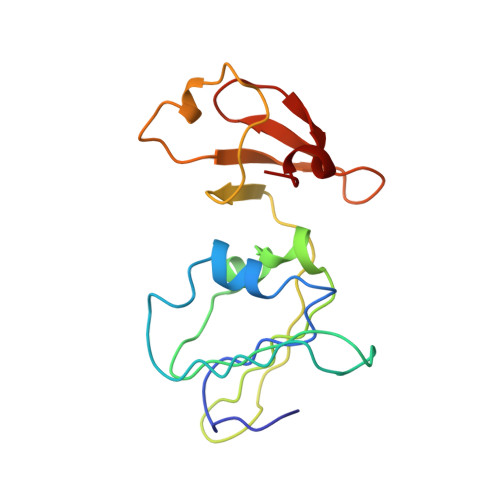Intersubunit hydrogen bond acts as a global molecular switch in Escherichia coli aspartate transcarbamoylase.
Ha, Y., Allewell, N.M.(1998) Proteins 33: 430-443
- PubMed: 9829701
- Primary Citation of Related Structures:
9ATC - PubMed Abstract:
Tyr 165 in the catalytic subunit of Escherichia coli aspartate transcarbamoylase (ATCase, EC 2.1.3.2) forms an intersubunit hydrogen bond in the T state with Glu 239 in the 240s loop of a second catalytic subunit, which is broken in the T to R transition. Substitution of Tyr 165 by Phe lowers substrate affinity by approximately an order of magnitude and alters the pH profile for enzyme function. We have determined the crystal structure of Y165F at 2.4 A resolution by molecular replacement, using a wild-type T state structure as the probe, and refined it to an R value of 25.2%. The Y165F mutation induces a global conformational change that is in the opposite direction to the T to R transition and therefore results in an extreme T state. The two catalytic trimers move closer by approximately 0.14 A and rotate by approximately 0.2 degrees , in the opposite direction to the T-->R rotation; the two domains of each catalytic chain rotate by approximately 2.1 degrees, also in the opposite direction to the T-->R transition; and the 240s loop adopts a new conformation. Residues 229 to 236 shift by approximately 2.4 A so that the active site is more open. Residues 237 to 244 rotate by approximately 24.1 degrees, altering interactions within the 240s loop and at the C1-C4 and C1-R4 interfaces. Arg 167, a key residue in domain closure and interactions with L-Asp, swings out from the active site to interact with Tyr 197. This crystal structure is consistent with the functional properties of Y165F, expands our knowledge of the conformational repertoire of ATCase, and indicates that the canonical T state does not represent an extreme.
Organizational Affiliation:
Department of Biochemistry, College of Biological Sciences, University of Minnesota, St. Paul 55108, USA.
















